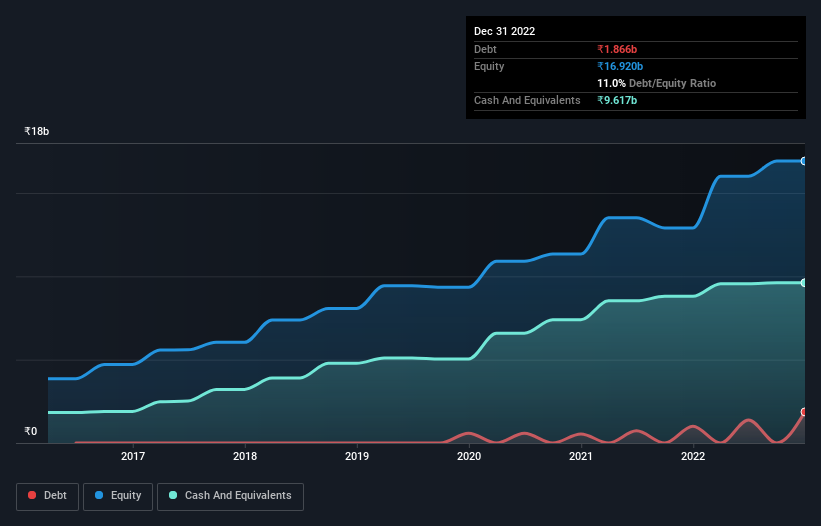Does Tata Elxsi (NSE:TATAELXSI) Have A Healthy Balance Sheet?

Warren Buffett famously said, 'Volatility is far from synonymous with risk.' When we think about how risky a company is, we always like to look at its use of debt, since debt overload can lead to ruin. As with many other companies Tata Elxsi Limited (NSE:TATAELXSI) makes use of debt. But should shareholders be worried about its use of debt?
When Is Debt Dangerous?
Debt and other liabilities become risky for a business when it cannot easily fulfill those obligations, either with free cash flow or by raising capital at an attractive price. If things get really bad, the lenders can take control of the business. However, a more common (but still painful) scenario is that it has to raise new equity capital at a low price, thus permanently diluting shareholders. Of course, the upside of debt is that it often represents cheap capital, especially when it replaces dilution in a company with the ability to reinvest at high rates of return. When we think about a company's use of debt, we first look at cash and debt together.
See our latest analysis for Tata Elxsi
How Much Debt Does Tata Elxsi Carry?
As you can see below, at the end of September 2022, Tata Elxsi had ₹1.87b of debt, up from ₹1.01b a year ago. Click the image for more detail. However, its balance sheet shows it holds ₹9.62b in cash, so it actually has ₹7.75b net cash.

A Look At Tata Elxsi's Liabilities
According to the last reported balance sheet, Tata Elxsi had liabilities of ₹4.08b due within 12 months, and liabilities of ₹2.06b due beyond 12 months. On the other hand, it had cash of ₹9.62b and ₹7.68b worth of receivables due within a year. So it can boast ₹11.2b more liquid assets than total liabilities.
This short term liquidity is a sign that Tata Elxsi could probably pay off its debt with ease, as its balance sheet is far from stretched. Simply put, the fact that Tata Elxsi has more cash than debt is arguably a good indication that it can manage its debt safely.
Another good sign is that Tata Elxsi has been able to increase its EBIT by 29% in twelve months, making it easier to pay down debt. The balance sheet is clearly the area to focus on when you are analysing debt. But it is future earnings, more than anything, that will determine Tata Elxsi's ability to maintain a healthy balance sheet going forward. So if you want to see what the professionals think, you might find this free report on analyst profit forecasts to be interesting.
Finally, while the tax-man may adore accounting profits, lenders only accept cold hard cash. Tata Elxsi may have net cash on the balance sheet, but it is still interesting to look at how well the business converts its earnings before interest and tax (EBIT) to free cash flow, because that will influence both its need for, and its capacity to manage debt. Over the most recent three years, Tata Elxsi recorded free cash flow worth 62% of its EBIT, which is around normal, given free cash flow excludes interest and tax. This cold hard cash means it can reduce its debt when it wants to.
Summing Up
While we empathize with investors who find debt concerning, you should keep in mind that Tata Elxsi has net cash of ₹7.75b, as well as more liquid assets than liabilities. And it impressed us with its EBIT growth of 29% over the last year. So we don't think Tata Elxsi's use of debt is risky. There's no doubt that we learn most about debt from the balance sheet. However, not all investment risk resides within the balance sheet - far from it. We've identified 1 warning sign with Tata Elxsi , and understanding them should be part of your investment process.
If, after all that, you're more interested in a fast growing company with a rock-solid balance sheet, then check out our list of net cash growth stocks without delay.
Valuation is complex, but we're here to simplify it.
Discover if Tata Elxsi might be undervalued or overvalued with our detailed analysis, featuring fair value estimates, potential risks, dividends, insider trades, and its financial condition.
Access Free AnalysisHave feedback on this article? Concerned about the content? Get in touch with us directly. Alternatively, email editorial-team (at) simplywallst.com.
This article by Simply Wall St is general in nature. We provide commentary based on historical data and analyst forecasts only using an unbiased methodology and our articles are not intended to be financial advice. It does not constitute a recommendation to buy or sell any stock, and does not take account of your objectives, or your financial situation. We aim to bring you long-term focused analysis driven by fundamental data. Note that our analysis may not factor in the latest price-sensitive company announcements or qualitative material. Simply Wall St has no position in any stocks mentioned.
About NSEI:TATAELXSI
Tata Elxsi
Engages in the provision of product design and engineering, and systems integration and support services in India, the United States, Europe, and internationally.
Flawless balance sheet established dividend payer.
Similar Companies
Market Insights
Community Narratives



